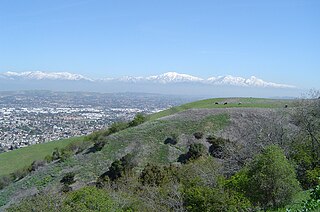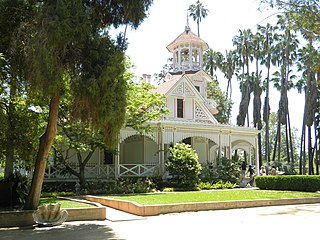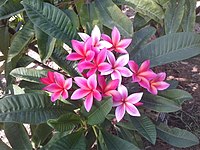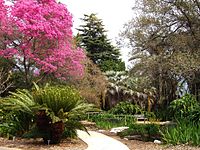
Mission San Gabriel Arcángel is a Californian mission and historic landmark in San Gabriel, California. It was founded by the Spanish Empire on "The Feast of the Birth of Mary," September 8, 1771, as the fourth of what would become twenty-one Spanish missions in California. San Gabriel Arcángel was named after the Archangel Gabriel and often referred to as the "Godmother of the Pueblo of Los Angeles."

Arcadia is a city in Los Angeles County, California, United States, located about 13 miles (21 km) northeast of downtown Los Angeles in the San Gabriel Valley and at the base of the San Gabriel Mountains. It contains a series of adjacent parks consisting of the Santa Anita Park racetrack, the Los Angeles County Arboretum and Botanic Garden, and Arcadia County Park. The city had a population of 56,364 at the 2010 census, up from 53,248 at the 2000 census. The city is named after Arcadia, Greece.

The San Gabriel Valley, often referred to by its initials as SGV, is one of the principal valleys of Southern California, with the city of Los Angeles directly bordering it to the west, and occupying the vast majority of the southeastern part of Los Angeles County. Surrounding landforms and other features include the following:

Colorado Boulevard is a major east–west street in Southern California. It runs from Griffith Park in Los Angeles east through Glendale, the Eagle Rock section of Los Angeles, Pasadena, and Arcadia, ending in Monrovia. The full route was once various state highways but is now locally maintained in favor of the parallel Ventura Freeway and Foothill Freeway (I-210).

Hugo Reid, a Scottish immigrant, was an early resident of Los Angeles County who became known for writing a series of newspaper articles, or "letters," that described the culture, language, and contemporary circumstances of the local Tongva (Gabrieleño) people. He criticized the Franciscan missionaries, who administered the Spanish missions in California, for their treatment of the native peoples.
The Hahamog'na, commonly anglicized to Hahamongna and spelled Xaxaamonga in their native language, are a tribe of the Tongva people of California. Their language belongs to the Uto-Aztecan family.

Elias Jackson "Lucky" Baldwin was "one of the greatest pioneers" of California business, an investor, and real estate speculator during the second half of the 19th century. He earned the nickname "Lucky" Baldwin due to his extraordinary good fortune in a number of business deals. He built the luxury Baldwin Hotel and Theatre in San Francisco and bought vast tracts of land in Southern California, where a number of places and neighborhoods are named after him.
Rancho Santa Anita was a 13,319-acre (53.90 km2) land grant in present-day Los Angeles County, California given to naturalized Scottish immigrant Hugo Reid and his Kizh people wife. Reid built an adobe residence there in 1839, and the land grant was formally recognized by Governor Pio Pico in 1845. The land grant covered all or portions of the present day cities of Arcadia, Monrovia, Sierra Madre, Pasadena and San Marino. A small portion of the rancho has been preserved as the Los Angeles County Arboretum and Botanic Garden.

Queen Anne Cottage and Coach Barn is a Victorian style pair of buildings at Baldwin Lake, on the grounds of the Los Angeles County Arboretum and Botanic Garden, located in Arcadia and the San Gabriel Valley of southern California.
Alyeupkigna is a former Tongva-Gabrieleño Native American settlement in Los Angeles County, California.
Quapa is a former Tongva village located in Encino or the San Fernando Valley in Los Angeles County, California. It was one of several villages located within the San Fernando Valley area, including Kowanga, Mapipinga, Okowvinja, Pascegna, Saway-yanga, Tacuenga, and Tuyunga.
Rancho Huerta de Cuati was a 127-acre (0.51 km2) Mexican land grant in the San Rafael Hills area of present-day Los Angeles County, California given in 1838 by governor Juan Alvarado to Victoria Reid. The name means "Cuati Garden" in Spanish. The rancho included present-day Alhambra, San Marino, South Pasadena, and Pasadena—and Lake Wilson.
Pasadena is a city in Los Angeles County, California, United States. Founded in 1874 and incorporated in 1886, the city is famous for its colorful history and for the hosting of both the Tournament of Roses Parade and the annual Rose Bowl game football game. It is also the home of the world-renowned California Institute of Technology (Caltech) and Jet Propulsion Laboratory (JPL)

Arcadia station is an at-grade light rail station on the A Line of the Los Angeles Metro Rail system. It is located at the intersection of 1st Avenue and Santa Clara Street in Arcadia, California, after which the station is named.

Baldwin Lake is a sag pond in the Los Angeles County Arboretum and Botanic Garden, which is in the San Gabriel Valley of Southern California, south of the San Gabriel Mountains. The pond, arboretum, and botanic garden are all within the city of Arcadia.

A Dawn In The West is the title of a 2013 bronze statue by Alfred Paredes of Elias J. “Lucky” Baldwin (1828–1909), pioneer California rancher, businessman founder and first mayor of Arcadia. Commissioned and donated to the City of Arcadia by Baldwin's great, great, great granddaughters, Margaux Gibson-Viera and Heather Gibson, both of California, the 9-foot bronze figure of Baldwin stands on a 4-foot concrete plinth in the center of the Monsignor Gerald M. O’Keefe Rose Garden, at the intersection of Huntington Drive and Holly Avenue, in Arcadia, California. It was dedicated on April 16, 2013.

The Los Angeles and San Gabriel Valley Railroad was a railroad founded on September 5, 1883, by James F. Crank with the goal of bringing a rail line to Pasadena, California from downtown Los Angeles, the line opened in 1886. Los Angeles and San Gabriel Valley Railroad was sold and consolidated on May 20, 1887 into the California Central Railway. In 1889 this was consolidated into Southern California Railway Company. On Jan. 17, 1906 Southern California Railway was sold to the Atchison, Topeka and Santa Fe Railway and called the Pasadena Subdivision. The main line closed in 1994. The railroad later reopened as the MTA Gold Line Light Rail service in July 2003.

The California Central Railway was incorporated on April 23, 1887, with headquarters in San Bernardino, California. George O. Manchester was the President of the corporation.

The Reid-Baldwin Adobe, formerly called the Hugo Reid Adobe, is an adobe house built in 1839. It is located at the Los Angeles County Arboretum and Botanic Garden in Arcadia, California. The Hugo Reid Adobe was designated a California Historic Landmark on April 3, 1940. The Reid Adobe was built by Scottish−Mexican Hugo Reid on the shore of what is now called Baldwin Lake, with the help of local natives. Reid received the full Mexican land grant for Rancho Santa Anita in 1845, which included 13,319 acres of land. Reid farmed some of the land and planted grape vines.





















